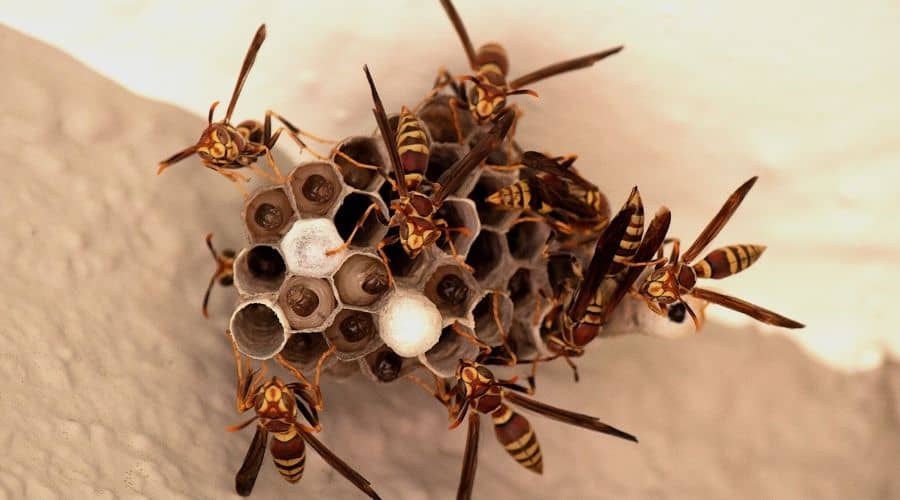When wasps get into the soffit, you can pull the nest out, but it will take more effort than that to keep them from rebuilding the colony in the same space.
Unfortunately, foam insulation isn’t enough to keep a determined wasp colony out of your soffits. Once they’re in the soffit, wasps get into attics and walls. How do you get rid of wasp nest behind the soffit?
The best way to get rid of a wasp nest behind the soffit is to use a powdered wasp poison around their entrances called Tempo dust. The wasps get the powder on their wings and carry it inside, spreading the poison to every colony member. After dusting the entry points, seal them with caulk or sealant.
Table of Contents
Best Way To Get Rid Of Wasps In Soffit
If your soffit is un-vented, the best way to get rid of wasps is to use powdered wasp poison around their entrances.
It’s important to know that powder wasp poisons only work when the weather is dry, so you can’t do this on a rainy day. However, an excellent nest-killing poison will work in 12 hours or less.
I recommend Bayer Tempo Dust from Amazon. This insecticidal dust works on numerous pests, and it’s suitable for soffits, crawlspaces, and other applications. You’ll be pleasantly surprised at how effective this formula is on wasps.
- NOT FOR SALE INTO CT, NJ OR NY
- Single, 50 gram water-soluble packet
- 1.6 ounces
- 3 x 1 x 2 inches
The wasps get the powder on their wings and carry it inside. Once there, the confined space causes wasps to rub against each other repeatedly, spreading the potent poison around to every colony member.
When you’re confident they are dead, remove the remaining nest.
3 Ways To Get Rid Of Wasp Nest Behind Soffit
There are only a few ways to remove the wasp nest itself. You will need a ladder, an excellent protective suit, gloves, and possibly a trash bag, though the latter depends on your method.
Nevertheless, you will need to kill the wasps first if you don’t want a trip to the hospital.
There are liquid sprays for smaller wasp nests. However, wasps can become immune to many chemical insecticides.
I suggest the powder because it typically uses ingredients you won’t find in the cheap sprays, and it’s known for its effectiveness.
That said, use whichever wasp killer you’re most comfortable with or have a pest control expert come out and do that part for you.
1 – Power Wash
Many homeowners consider a pressure washer indispensable for cleanup around the house. If you have vinyl siding and soffits, you’re probably one of them, and if you’re not, I suggest trying it out for yourself.
A high-quality adjustable pressure washer can reduce the time it takes to clean out a facade and the eves around your home and make the chores a lot easier.
Pressure washers are also great for driveways, dirty wooden porches, and more. Best of all, they can reach many soffits.
All you need to do is remove the outer panel to expose your dead wasp nest. You should be able to spray it out.
However, make sure there’s nothing else inside you could damage and no openings into the house, or you’ll have a wet mess.
2 – Vacuum
Wasps’ nests aren’t particularly heavy or difficult to pull out, but they can be messy. A good shop vac will cut down the time and mess significantly.
You’ll need an extension cord, and you may also need a sturdy platform to set your shop vac on top of. Still, this is a fast, relatively mess-free way to get old dead wasp nests out of your soffit.
3 – Manual Removal
Sometimes you have to get your hands dirty. If you don’t have or can’t utilize a shop vac or pressure washer, the best option is to dig in manually.
You’re going to want a trash bag or two for this method. Additionally, I suggest placing your ladder where you can easily and safely reach the nest, but not so you’re standing directly below it.
This prevents chunks of dead wasp and their former home from falling in your face.
Wasp Proof Soffit Vents
A few commercial soffit vents are sold as fly-proof, but they tend to be cheap or far from universal. Fortunately, with basic household tools and some mesh screen, you can wasp-proof your soffit vents in a few minutes.
Follow the steps below for DIY wasp-proof soffit vents:
- Measure the opening for your vent.
- Cut a piece of rustproof steel mesh screen just slightly larger than the hole.
- Remove your soffit vent cover or the whole vent, depending on its style.
- Fit the screen inside your soffit vent and secure it around the edges with a caulk or another weatherproof adhesive.
- Replace the soffit vent, and you’re done. It is that simple.
- (Optional) seal up any other openings or cracks to help keep wasps out
Helpful Tips To Know About How To Get Rid Of Wasp Nest Behind Soffit
Dealing with wasps in the yard is bad enough, but when they get into the soffit it’s easy for wasps to expand to crawl spaces and other dangerous areas. It’s vital to protect yourself and your home from these stinging invaders.
Here are some helpful tips to know about how to get rid of wasp nest behind the soffit.
- Preventing a new colony of wasps from taking over your soffit is as important as removing the previous one. While wasps don’t reuse old nest spaces, they are fond of taking over another colony’s former home. Seal up any openings in your soffit with caulk and make sure you wasp proof any vents. Taking these relatively quick and simple additional steps can save you a lot of trouble down the line. After all, you don’t want to do this twice if you don’t have to.
- Keeping your yard clean and free of trash or food is a great way to help deter wasps. If you don’t have a mess there will be fewer insects, which the wasps need to prey on and drag back to their nest to feed the wasp larva. You can also avoid planting flowering plants near your home since adult wasps drink the nectar for food.
- Wasp colonies can get massive very quickly because their eggs hatch in two or three days. A queen will lay an egg in every cell of the colony and each egg will become a wasp after molting five times, which takes a couple of weeks, and then pupating for another week or two. It seems like a long time, but the hatching and pupating is staggered since queens lay eggs continuously.
Final Thoughts
Wasps are enough of a challenge when they’re not inside the roof of your home. As soon as you suspect you see wasps going into the soffit it is essential to check it out or hire a professional to take a look and eliminate anything you find there.
No one wants wasps inside the house. Soffits often offer access to crawlspace and walls, making it easier for wasps to expand their colonies.
Use wasp spray, dust, a vacuum, or a professional to get rid of bidding wasp colonies before they have time to become a bigger threat.


